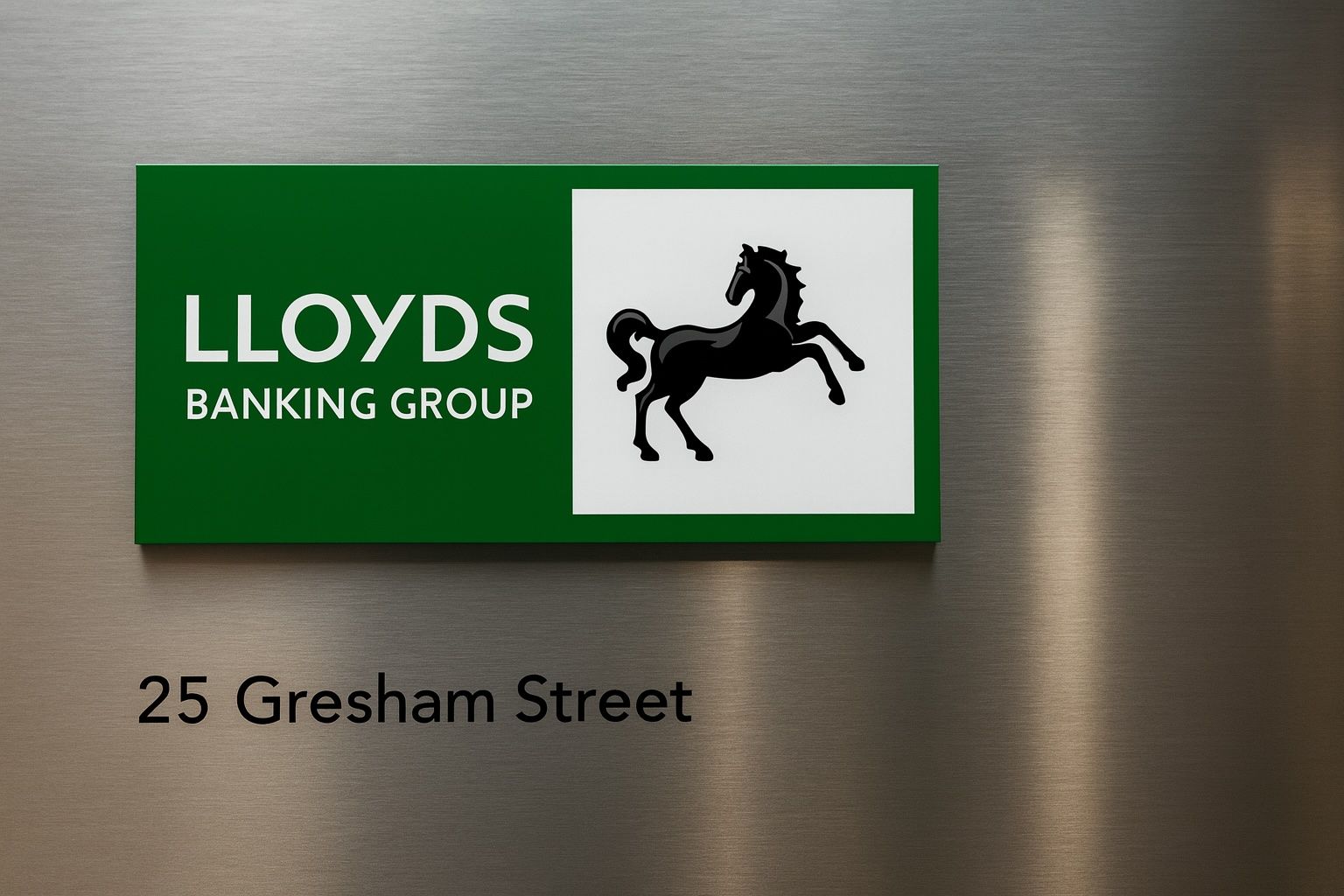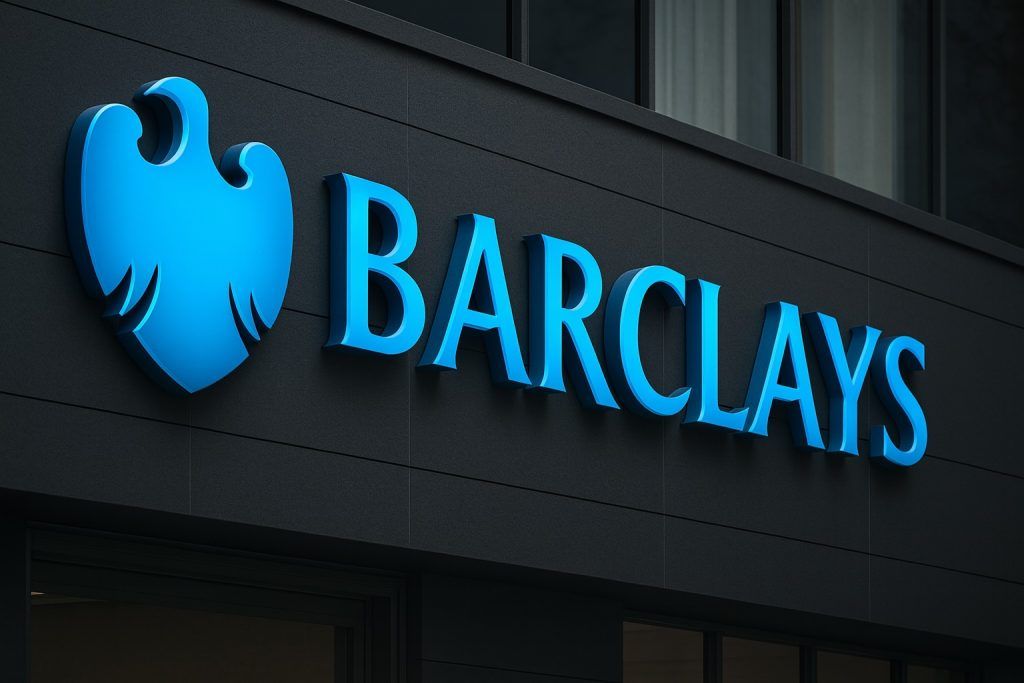Lloyds Banking Group heads into the new trading week with its share price just below recent highs, but with a packed agenda of news and macro risks that could shape trading when the London Stock Exchange opens on Monday, 17 November 2025.
From a fresh £120m fintech acquisition and a live £1.7bn buyback, to the motor finance mis‑selling scandal and a staff data‑privacy row, there’s a lot sitting behind the ticker LLOY right now. Here’s what you need to know before the bell.
Where the Lloyds share price stands before Monday’s open
At the close of trading on Friday, 14 November 2025, Lloyds Banking Group’s London‑listed shares were quoted with:
- Sell (bid): 91.74p
- Buy (offer): 91.76p
- Daily move: down 2.62p, a fall of about 2.78% versus the previous close at 94.12p [1]
Intraday on Friday, the shares traded between roughly 90.1p and 93.0p, after opening at 90.28p. [2]
Despite the pull‑back into the weekend, Lloyds has been on a strong run:
- 52‑week high: 95.70p (set on 13 November 2025)
- 52‑week low: 52.44p
- 1‑year performance: up about 66%
- Market capitalisation: ~£53.9bn
- Trailing P/E ratio: about 15x
- Dividend yield: roughly 3.5%, based on recent dividends [3]
Friday’s weakness wasn’t just about Lloyds. The FTSE 350 banks index fell about 2.2%, while the FTSE 100 dropped 1.1% as investors fretted over global growth and fresh uncertainty around the UK Autumn Budget. Lloyds, often treated as a barometer of the domestic economy, was among the top FTSE 100 fallers, sliding nearly 3% to around 91.6p. [4]
So the stock starts Monday not far below a new year‑high zone, but with clear evidence of profit‑taking and macro nerves.
What moved LLOY last week
1. Bank of England holds at 4% – but only just
On 6 November 2025, the Bank of England’s Monetary Policy Committee voted 5–4 to keep the base rate at 4%, with four members pushing for a 0.25 percentage‑point cut to 3.75%. [5]
Key takeaways for a domestically focused lender like Lloyds:
- The Bank now sees risks to inflation and growth as more balanced, but wants more data before cutting further. [6]
- Markets are pricing a meaningful chance of a rate cut at the December meeting if disinflation continues. [7]
For Lloyds, lower rates over time typically put pressure on net interest margins, but also support borrowers and asset quality. In the short term, these finely balanced rate expectations feed into volatility for UK bank stocks, which is exactly what was seen in Friday’s sell‑off.
2. Autumn Budget and tax uncertainty
Investors are also watching Chancellor Rachel Reeves’ first Budget later in November.
Reporting from the Guardian suggests that major UK banks, including Lloyds, are likely to avoid new sector‑specific tax hikes, after lobbying on competitiveness and the already‑high tax burden on banks. [8]
However, City A.M. notes that markets remain jittery as Reeves reworks broader income tax plans, sparking worries that banks could drift back into the tax spotlight as a revenue source. [9]
For Monday’s open, any weekend Budget leaks or commentary could influence sentiment towards LLOY and the wider UK banking cohort.
3. Ongoing £1.7bn share buyback
Lloyds is in the middle of a sizeable share buyback programme, designed to return capital and support earnings per share:
- The programme, announced earlier in the year, is set to repurchase up to £1.7bn of ordinary shares and run no later than 31 December 2025. [10]
- On 14 November 2025 alone, Lloyds bought 10.45m shares at prices between 90.16p and 91.66p, with a volume‑weighted average price just over 91.0p. These shares are being cancelled. [11]
The buyback effectively introduces a steady buyer into the market at current levels, which can cushion downside moves – though it doesn’t eliminate fundamental risks.
Big new story: a £120m deal for digital wallet provider Curve
The headline strategic development for Lloyds this week is its move deeper into fintech.
Multiple reports from Sky News, Sharecast and specialist payments outlets say Lloyds has agreed a £120m deal to acquire Curve, the London‑based digital wallet and card‑consolidation platform. [12]
What Curve does:
- Combines multiple cards into a single “all‑in‑one” smart wallet, both physical and digital.
- Offers a data‑rich spending dashboard, budgeting tools and card‑switching features that appeal to younger and tech‑savvy customers. [13]
Why it matters for the Lloyds share price:
- The acquisition is a clear bet on embedded finance and payments, areas that can generate fee income and deepen customer engagement beyond traditional loans and deposits. [14]
- Investors will be watching the open for any further detail on integration plans, synergy targets and the expected impact on returns — especially after some Curve investors reportedly expressed frustration at the sale price. [15]
Short term, any reaction will likely hinge on whether the market sees this as a capital‑light growth move or worries about execution risk and cultural integration with a nimble fintech.
Digital strategy: AI assistant and branch closures
AI‑powered financial assistant
On 6 November 2025, Lloyds announced it is launching what it calls the UK’s first multi‑feature, large‑scale AI‑powered financial assistant, due to roll out to mobile app users from early 2026. [16]
Key points:
- Will serve more than 21 million mobile app customers. [17]
- Designed to provide personalised insights on spending, budgeting, savings and investments.
- The bank positions AI as a “core enabler” across the group, not just a customer‑facing gimmick. [18]
For the share price, this reinforces the “digital pivot” narrative, supporting the idea that Lloyds can defend its franchise against challenger banks and big‑tech encroachment. The real test will be adoption, customer satisfaction – and whether the AI assistant can demonstrably improve cross‑sell and retention metrics.
Accelerating branch closures
At the same time, Lloyds continues to shrink its high‑street footprint:
- Earlier this year, the bank announced plans to close 136 branches between May 2025 and March 2026 across the Lloyds, Halifax and Bank of Scotland brands, citing the shift to digital banking. [19]
- Tabloid and money‑advice coverage this week highlighted 17 branch closures in November, including seven shutting in one week across towns such as Sheffield, Chard, Shipston‑on‑Stour, Debden, East Grinstead and Loughton, with more to follow. [20]
This feeds into two opposing narratives:
- Cost efficiency and digital focus, which investors tend to like.
- Political and reputational risk, particularly around financial exclusion of older or rural customers, which could invite more regulatory scrutiny.
The car finance scandal still hangs over Lloyds
The biggest overhang on the Lloyds share price remains the motor finance mis‑selling scandal.
Provisions and earnings impact
On 23 October 2025, Lloyds reported that:
- Q3 2025 pre‑tax profit fell 36% year‑on‑year to about £1.17bn, largely because of an additional £800m provision related to historic car finance commission practices. [21]
- Total provisions for the scandal now stand at around £1.95bn. [22]
- The bank cut its full‑year return on tangible equity (RoTE) guidance from 13.5% to roughly 12%. [23]
Yet the underlying performance was not all negative:
- Net interest income over the first nine months of 2025 was up about 6% year‑on‑year, helped by rate hedging. [24]
- Capital remains solid with a CET1 ratio of about 13.8%, and tangible net asset value per share continues to grow. [25]
FCA redress scheme uncertainty
The ultimate bill is still unclear. The UK’s Financial Conduct Authority (FCA) has proposed a redress scheme that:
- Could cost the industry around £11bn for undisclosed commission on an estimated 14 million historic car loans. [26]
- Suggests an interest component of 2.09% on compensation, which consumer groups argue is far too low and could short‑change borrowers by more than £4bn compared with a commercial rate around 7–8%. [27]
Lloyds, as the UK’s largest car lender via its Black Horse division, is expected to bear one of the biggest shares of the cost and has already signalled it may challenge aspects of the FCA’s methodology while still committing to compensate harmed customers. [28]
For Monday’s open, any signs of regulatory softening or clearer industry cost caps would be supportive for LLOY, while headlines pointing to tougher terms or legal escalation could weigh on the stock.
Property and “Lloyds the landlord”
Less discussed in the daily share‑price moves, but increasingly important, is Lloyds’ growing role as a landlord.
Recent coverage from the Financial Times and Guardian highlights that:
- Through its Lloyds Living division, the group has quietly built a UK rental property portfolio worth more than £2bn, owning around 7,000–7,500 homes and targeting tens of thousands more by 2030. [29]
- The focus is mainly on single‑family suburban housing, with some push into social and affordable housing projects. [30]
Strategically, this helps diversify income away from pure interest margins into rental and fee income, but also increases exposure to UK housing and introduces potential political scrutiny over a major bank’s role in the rental market.
Staff data‑privacy row adds a reputational wrinkle
Another issue that could influence sentiment – even if less directly financial in the short term – is a growing data‑privacy controversy.
- A specialist bank union (BTU) reported that Lloyds had analysed data from around 36,000 staff current accounts in lower‑grade roles to assess “financial resilience” ahead of pay talks for 2026–27. [31]
- The union argues that this amounted to “trawling” personal accounts without proper consent and says it will take the matter to the Information Commissioner’s Office. [32]
- Lloyds has said the data was used in anonymised, aggregated form, but the story has been widely picked up, including by the Financial Times. [33]
For investors, the risk is less about immediate fines and more about trust and regulatory tone, especially when viewed alongside the car finance issues.
Credit rating and sector backdrop: not all gloom
Despite the scandals and political noise, the broader credit and sector backdrop remains supportive:
- On 13 November 2025, Fitch Ratings affirmed Lloyds Banking Group’s long‑term issuer default rating at ‘A+’ with a Stable Outlook, and its Viability Rating at ‘a+’. [34]
- Fitch also commented that major UK banks are broadly hedged against macroeconomic risks, thanks to strong capital, conservative underwriting and interest‑rate hedging strategies. [35]
Separately, investment commentary hosted on Lloyds’ own investment platform argues that UK domestic stocks – including banks – may be undervalued, describing the UK as “one of the most misunderstood equity market stories”. [36]
This doesn’t remove near‑term volatility, but it gives some context for why Lloyds shares have rallied so strongly over the past year despite ongoing noise.
Valuation snapshot and key technical areas
Based on Friday’s close:
- Valuation: LLOY trades around 15x trailing earnings and yields roughly 3.5% in dividends, with additional capital returns via the buyback. [37]
- Recent range: Support is visible around the 90p area (Friday’s low was just above 90p), while the 95–96p region marks recent 52‑week highs. [38]
Traders watching the open on 17 November will likely have an eye on:
- Whether 90p holds as near‑term support if sentiment is weak.
- How quickly buyers step in around current levels, including any visible impact from daily buyback activity. [39]
What to watch as London opens on 17 November 2025
When the market opens, these are likely to be the key focus points around the Lloyds share price:
- Reaction to the Curve deal
- Any weekend analysis questioning the price tag, strategic logic or regulatory approval timetable.
- Commentary from fintech and payments specialists on how Curve fits into the wider competitive landscape. [40]
- Macro tone: rates and Budget chatter
- Car finance headlines
- Fresh commentary on the FCA redress consultation, especially around the controversial 2.09% interest rate assumption. [43]
- Flows and positioning
- Reputational stories
- Follow‑up pieces on the staff account‑data controversy and ongoing branch closures, which can affect the political and regulatory backdrop even if they don’t immediately move earnings. [46]
Main risks to keep in mind
Even if Monday’s open is calm, anyone following LLOY should keep these medium‑term risk themes on the radar:
- Regulatory risk
- Macro and housing
- A weaker UK economy or housing downturn would pressure Lloyds’ core mortgage and unsecured portfolios, even though current asset quality metrics are strong. [49]
- Execution risk
- Integrating Curve and successfully rolling out the AI assistant at scale, on time and within budget, will be key tests. [50]
- Political risk
- Branch closures and landlord activities could attract more political scrutiny, especially if living‑cost pressures remain in the headlines. [51]
Bottom line
Going into the 17 November 2025 London open, the Lloyds share price is:
- Sitting close to year‑high territory after a strong 12‑month rally. [52]
- Backed by a large ongoing share buyback, a solid capital position and an A+ / Stable credit rating. [53]
- Yet still shadowed by the motor finance mis‑selling scandal, a live FCA redress consultation, and growing scrutiny of its use of customer and staff data. [54]
Add in the BoE’s knife‑edge rate decisions, the Autumn Budget and a fresh fintech acquisition, and LLOY is likely to remain highly news‑sensitive around the open.
As always, this overview is informational only and not personal investment advice. Lloyds shares, like all equities, can go down as well as up, and any decision to buy, sell or hold should be based on your own research, objectives and risk tolerance, or taken with the help of a regulated financial adviser.
References
1. www.hl.co.uk, 2. www.hl.co.uk, 3. www.hl.co.uk, 4. www.cityam.com, 5. www.bankofengland.co.uk, 6. www.bankofengland.co.uk, 7. www.reuters.com, 8. www.theguardian.com, 9. www.cityam.com, 10. www.investegate.co.uk, 11. www.londonstockexchange.com, 12. news.sky.com, 13. payspacemagazine.com, 14. payspacemagazine.com, 15. www.fintechweekly.com, 16. www.lloydsbankinggroup.com, 17. www.crowdfundinsider.com, 18. www.lloydsbankinggroup.com, 19. www.reuters.com, 20. www.thescottishsun.co.uk, 21. www.reuters.com, 22. www.reuters.com, 23. www.reuters.com, 24. www.reuters.com, 25. www.lloydsbankinggroup.com, 26. www.theguardian.com, 27. www.theguardian.com, 28. www.reuters.com, 29. www.ft.com, 30. www.theguardian.com, 31. btuonline.co.uk, 32. btuonline.co.uk, 33. www.ft.com, 34. www.tradingview.com, 35. www.fitchratings.com, 36. www.investments.lloydsbank.com, 37. www.hl.co.uk, 38. www.hl.co.uk, 39. www.londonstockexchange.com, 40. news.sky.com, 41. www.bankofengland.co.uk, 42. www.theguardian.com, 43. www.theguardian.com, 44. www.hl.co.uk, 45. www.londonstockexchange.com, 46. btuonline.co.uk, 47. www.reuters.com, 48. btuonline.co.uk, 49. www.lloydsbankinggroup.com, 50. payspacemagazine.com, 51. www.ft.com, 52. www.hl.co.uk, 53. www.investegate.co.uk, 54. www.reuters.com








